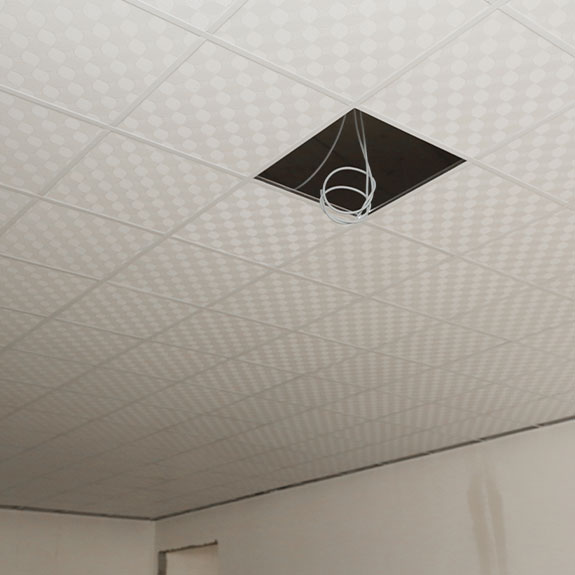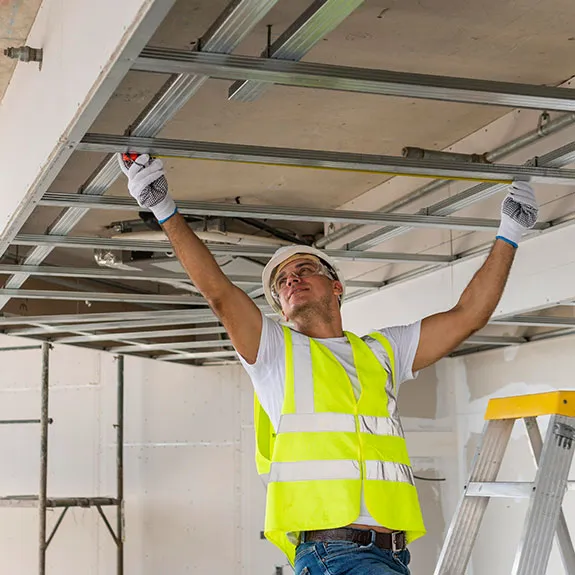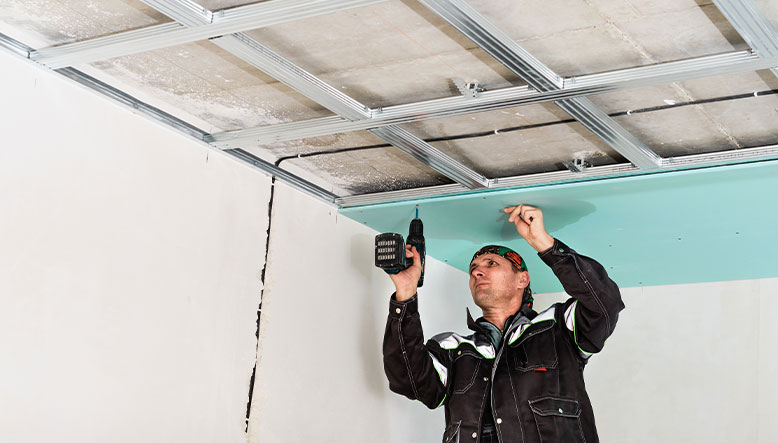Installing a suspended ceiling is an increasingly popular solution in homes and offices thanks to its benefits in aesthetics, comfort and energy efficiency. This suspended structure not only improves the visual appearance of a space, but also optimizes thermal and acoustic insulation, as well as facilitating the concealment of installations. Below, we explore all the advantages of a suspended ceiling and how to choose the right type for your needs.
What is a false ceiling and what is it used for?
A false ceiling is a structure installed under the original ceiling, which creates an additional layer for both practical and aesthetic purposes. Composed of panels or plates of various materials(plasterboard, wood, metal, etc.), a false ceiling can be adapted to the specific needs of each space.

False ceilings are useful for:
- Improve the aesthetics of the environment, achieving a modern and refined look.
- Insulate the house thermally and acoustically.
- Conceal installations such as cables, pipes and ventilation ducts.
- Integrate recessed lighting and other technologies, optimizing the design and functionality of the space.
There are several types of false ceilings, such as plasterboard (ideal for homes), removable ceilings (common in offices) and wood or metal ceilings, which offer a special aesthetic and greater durability.
Advantages of installing a false ceiling in the home
1. Improved thermal insulation
Suspended ceilings help maintain the temperature of the home by reducing heat loss in winter and excess heat in summer. By creating an additional insulating layer, the suspended ceiling minimizes the need for heating and air conditioning, reducing energy consumption and, consequently, energy bills.
2. Acoustic insulation
A suspended ceiling provides an effective barrier against both external and internal noise, making it an excellent choice for homes in urban areas or multi-story buildings. Absorbent acoustic panels, such as mineral fiber or rock wool, are especially recommended to maximize noise reduction and increase privacy.
3. Concealment of installations
Installing a false ceiling allows hiding cables, pipes, air ducts and air conditioning systems, keeping the design clean and tidy. In addition, it facilitates the installation of recessed lighting, eliminating the need for pendant lights and leaving an elegant and functional finish.
4. Improved aesthetics and design flexibility
Available in a variety of materials and finishes, such as plasterboard, wood and metal, the false ceiling can be adapted to a wide range of decorative styles. This allows to create from a minimalist to a more sophisticated design, enhancing the ambiance of the space.
5. Moisture and fire protection
Some suspended ceiling materials, such as certain types of plasterboard, offer fire and moisture resistance, increasing safety in exposed areas such as the kitchen or bathroom. This feature not only provides greater durability, but also contributes to the safety of the home.
Types of suspended ceilings for different needs
False plasterboard ceilings
Plasterboard is a very popular choice in homes due to its ease of installation and excellent thermal and acoustic insulation capabilities. This material also offers a smooth surface that is ideal for paint or wallpaper finishes, adapting well to any decorative style.
Removable suspended ceilings
Demountable ceilings are common in offices and commercial spaces, as they allow easy access to electrical and HVAC installations for maintenance or repairs. The panels are easy to remove and install, allowing for greater flexibility in these environments.
Wood and metal false ceilings
For those looking for a unique and durable style, wood or metal suspended ceilings are an excellent choice. These materials not only add a special and distinctive touch, but are also resistant to moisture and wear, making them an attractive option for those looking for quality and design.
Installation process and recommendations
The installation of a suspended ceiling begins with the planning of the design and the choice of suitable materials, according to the needs of the space. A professional must evaluate the height of the original ceiling and the purpose of the installation(insulation, aesthetics, accessibility) to determine the right system. In addition, having experts ensure a safe and efficient installation, avoiding problems such as condensation or poor fit of the panels.

Steps in the process:
- Planning and design: Selecting the right type of material and design.
- Preparation of the space: Clean and prepare the surface, adjusting the height of the structure.
- Installation of the panels or plates: Assemble the structure and fix the panels accurately.
- Finishing and final adjustments: Perform the necessary touch-ups to ensure that the false ceiling is perfectly aligned and sealed.
When finished, the result is an aesthetically pleasing and functional roof that optimizes energy efficiency and enhances the design of the home.
Installing a false ceiling offers multiple benefits, from better thermal and acoustic insulation to a considerable aesthetic improvement. If you are thinking of transforming your home or improving its efficiency, in ParatuReforma you will find the best materials to install your false ceiling, guaranteeing a high quality installation adapted to your needs.
How long does it take to install a false ceiling?
Installation usually takes one to three days, depending on the size of the space and the type of material chosen. Simpler structures, such as plasterboard ceilings in small rooms, can be completed in less time.
Is a false ceiling suitable for a kitchen or bathroom?
Yes, as long as moisture-resistant materials such as water-repellent plasterboard or aluminum panels are used. These materials are designed to prevent condensation and mold problems, providing a durable and safe solution for damp areas.
What materials are best for an acoustic false ceiling?
Mineral fiber or rock wool acoustic panels are highly effective in reducing noise by absorbing sound waves and improving sound insulation. Plasterboard also provides good sound insulation, especially when combined with additional absorbent materials.






